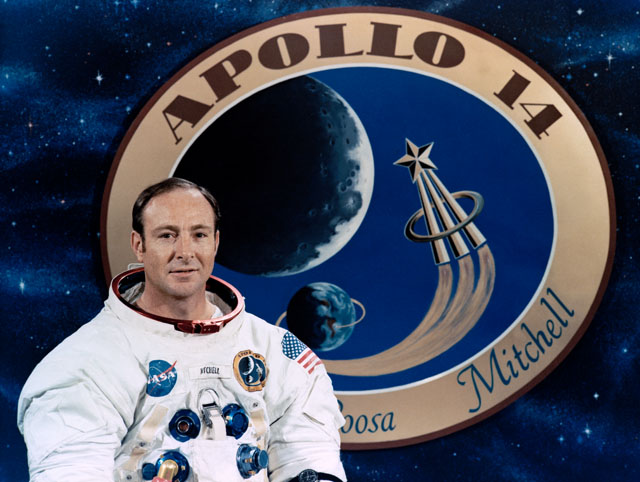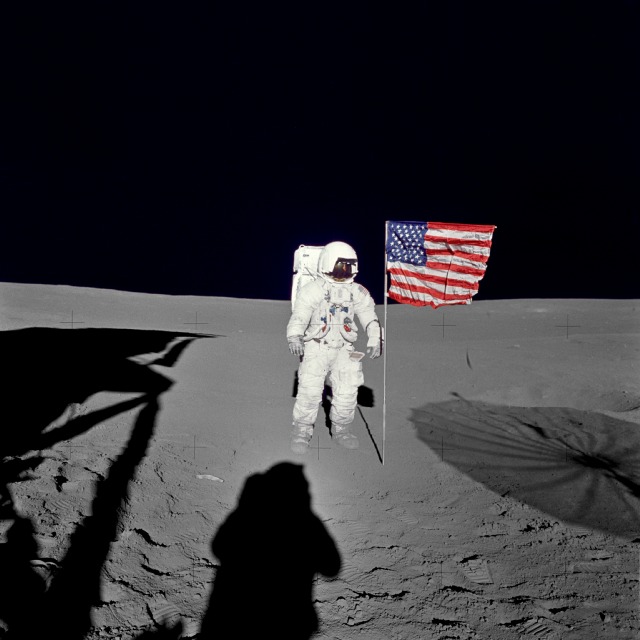Edgar Mitchell: Sixth Man on the Moon

Edgar Mitchell, who flew on Apollo 14, was the sixth man to walk on the moon. Along with Alan Shepard, Mitchell explored the Fra Mauro region for two days, taking over the territory that the ill-fated Apollo 13 mission never reached.
Mitchell, who got his start in the Navy before joining NASA, subsequently retired from both institutions to pursue a passion of his: understanding the nature of human consciousness.
His exposure to space travel, Mitchell has said, made him more aware of the connections between humans. Besides his work on consciousness, Mitchell also was a founder of the Association of Space Explorers.
In 2011, Mitchell surrendered an Apollo-era camera in his possession to the federal government rather than face a lawsuit over his attempt to sell it in auction.
Early career
Mitchell, who joined the Navy in 1952, started thinking about being an astronaut just five years later, according to an interview he did with NASA's Johnson Space Center in 1997.
"I made the decision in 1957, when Sputnik went up," he recalled.
"I realized humans were going to be right behind it, so I started orienting my career toward that at that time ... It took nine years, but I got a doctorate, got additional flight experience, additional jet hours, was assigned to the Manned Orbiting Laboratory Program for a while, so, getting space management experience."
Lastly, before entering NASA, Mitchell worked at the U.S. Air Force Aerospace Research Pilot School in duties that were intended to prepare him for being an astronaut. He also was an instructor in navigation and advanced mathematicians for other people seeking to join the corps.
Mitchell was selected in April 1966, and as was typical for astronauts served on a couple of backup assignments before getting a flight himself. He was a member of the astronaut support crew for Apollo 9, and backed up the lunar module pilot position for Apollo 10 – the first mission to fly that type of spacecraft near the moon.
Apollo 14
Ed Mitchell was initially selected as lunar module pilot for Apollo 13 along with Alan Shepard, who would command the mission, and Stuart Roosa, who would stay on board the spacecraft in the orbiting command module.
Mitchell and Roosa had no spaceflight experience, and Shepard had spent just minutes in space aboard the inaugural Mercury mission, Freedom 7. Some dubbed the crew "the three rookies."
As training progressed, Shepard – who had been out of the rotation for a while due to inner ear problems – elected to take more time and to slip the crew back a flight to Apollo 14.
Apollo 13 ended up being a near-disaster after an oxygen tank ruptured in space, and additional safety measures and procedures were put in before Apollo 14 left the ground.
Apollo 14 lifted off on Jan. 31, 1971, and safely made it to Fra Mauro, despite facing a glitch that threatened a required spacecraft docking early in the mission. This mission, the first in the lunar highlands, yielded 100 pounds of rock for scientists back on Earth.

Famously, the crew lost their way en route to one of the science targets, Cone Crater – it's hard to judge distances on the landmark-less moon – and had to turn away when they were unknowinglyonly 100 feet from the rim.
According to author Andrew Chaikin in his book, "A Man on the Moon," this incident helped spur greater geology training for the subsequent crews of Apollo 15, 16 and 17.
Apollo 14 is also known as the mission where Shepard hit a golf ball on the surface. "Miles and miles and miles!" Shepard gleefully shouted.
Noetic sciences
Mitchell returned from the moon a changed man. From his experience in the cosmos, he said he had gained a greater awareness of the forces that shape the universe.
"As he hurtled earthward through the abyss between the two worlds, Mitchell became engulfed by a profound sensation, 'a sense of universal connectedness,' " Mitchell's website states.
"He intuitively sensed that his presence, that of his fellow astronauts, and that of the planet in the window were all part of a deliberate, universal process and that the glittering cosmos itself was in some way conscious. The experience was so overwhelming Mitchell knew his life would never be the same."
Mitchell founded the Institute of Noetic Sciences in the 1970s to explore better what consciousness is, and how it "relates to cosmology and causality," the website adds.
"He has devoted the last 38 years to studying human consciousness and psychic and paranormal phenomena in the search for a common ground between science and spirit."
He also forged connections with his fellow astronauts through founding the Association of Space Explorers, which represents those who have made the journey into space.
— Elizabeth Howell, SPACE.com Contributor
Join our Space Forums to keep talking space on the latest missions, night sky and more! And if you have a news tip, correction or comment, let us know at: community@space.com.
Get the Space.com Newsletter
Breaking space news, the latest updates on rocket launches, skywatching events and more!

Elizabeth Howell (she/her), Ph.D., was a staff writer in the spaceflight channel between 2022 and 2024 specializing in Canadian space news. She was contributing writer for Space.com for 10 years from 2012 to 2024. Elizabeth's reporting includes multiple exclusives with the White House, leading world coverage about a lost-and-found space tomato on the International Space Station, witnessing five human spaceflight launches on two continents, flying parabolic, working inside a spacesuit, and participating in a simulated Mars mission. Her latest book, "Why Am I Taller?" (ECW Press, 2022) is co-written with astronaut Dave Williams.










